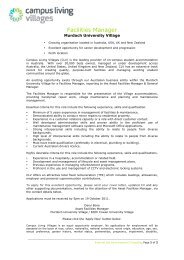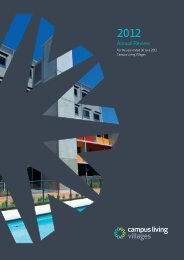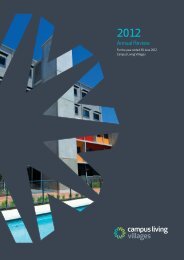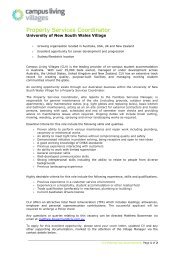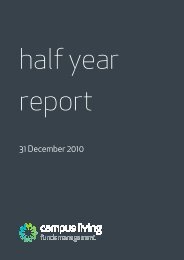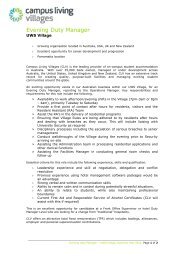Annual Report - Campus Living Villages
Annual Report - Campus Living Villages
Annual Report - Campus Living Villages
Create successful ePaper yourself
Turn your PDF publications into a flip-book with our unique Google optimized e-Paper software.
6 0 <strong>Campus</strong> <strong>Living</strong> <strong>Villages</strong> <strong>Annual</strong> <strong>Report</strong> 09/10<br />
<strong>Campus</strong> <strong>Living</strong> Australia Trust<br />
NOTES TO THE CONSOLIDATED FINANCIAL STATEMENTS<br />
FOR THE YEAR ENDED 30 JUNE 2010<br />
A$’000<br />
CLAT<br />
Upon receipt of a funding advice any group member will pay<br />
the head entity the amount allocated to the group member<br />
within the time frame specified in the funding advice. In the<br />
event that the head entity owes the group member, the same<br />
terms will apply. The tax funding arrangement allows this<br />
payment to be settled by way of intercompany account.<br />
f) Leases<br />
Leases of property, plant and equipment where the<br />
consolidated entity, as lessee, has substantially all the risks<br />
and rewards of ownership are classified as finance leases.<br />
Finance leases are capitalised at the lease’s inception at the<br />
fair value of the leased property or, if lower, the present value<br />
of the minimum lease payments. The corresponding rental<br />
obligations, net of finance charges, are included in other shortterm<br />
and long-term payables. Each lease payment is allocated<br />
between the liability and finance cost.<br />
The finance cost is charged to the income statement over<br />
the lease period so as to produce a constant periodic rate<br />
of interest on the remaining balance of the liability for each<br />
period. The property, plant and equipment acquired under<br />
finance leases is depreciated over the shorter of the asset’s<br />
useful life and the lease term.<br />
Leases in which a significant portion of the risks and rewards<br />
of ownership are not transferred to the consolidated entity<br />
as lessee are classified as operating leases. Payments made<br />
under operating leases (net of any incentives received from<br />
the lessor) are charged to the income statement on a straightline<br />
basis over the period of the lease.<br />
g) Business combinations<br />
The purchase method of accounting is used to account for<br />
all business combinations, including business combinations<br />
involving entities or businesses under common control,<br />
regardless of whether equity instruments or other assets<br />
are acquired. Cost is measured as the fair value of the<br />
assets given, equity instruments issued or liabilities incurred<br />
or assumed at the date of exchange plus costs directly<br />
attributable to the acquisition. Where equity instruments<br />
are issued in an acquisition, the fair value of the instruments<br />
is their published market price as at the date of exchange<br />
unless, in rare circumstances, it can be demonstrated that<br />
the published price at the date of exchange is an unreliable<br />
indicator of fair value and that other evidence and valuation<br />
methods provide a more reliable measure of fair value.<br />
Transaction costs arising on the issue of equity instruments<br />
are recognised directly in equity.<br />
Identifiable assets acquired and liabilities and contingent<br />
liabilities assumed in a business combination are measured<br />
initially at their fair values at the acquisition date, irrespective<br />
of the extent of any minority interest.<br />
The excess of the cost of acquisition over the fair value of<br />
the consolidated entity’s share of the identifiable net assets<br />
acquired is recorded as goodwill. If the cost of acquisition<br />
is less than the consolidated entity’s share of the fair value<br />
of the identifiable net assets of the subsidiary acquired, the<br />
difference is recognised directly in the income statement,<br />
but only after a reassessment of the identification and<br />
measurement of the net assets acquired.<br />
Where settlement of any part of cash consideration is<br />
deferred, the amounts payable in the future are discounted to<br />
their present value as at the date of exchange. The discount<br />
rate used is the entity’s incremental borrowing rate, being the<br />
rate at which a similar borrowing could be obtained from an<br />
independent financier under comparable terms and conditions.<br />
Identification of the acquirer<br />
The acquirer in a business combination must be identified.<br />
The acquirer is the combining entity that obtains control of the<br />
other combining entities or businesses. Control is the power<br />
to govern the financial and operating policies of an entity or<br />
business so as to obtain benefits from its activities.<br />
In the event that the acquirer identified is not the legal<br />
parent of the business combination, the issued capital of the<br />
consolidated entity reflects the issued capital of the acquirer<br />
amended for the appropriate fair value adjustments of the<br />
business combination.<br />
h) Impairment of assets<br />
Goodwill is not subject to amortisation and is tested annually<br />
for impairment or more frequently if events or changes in<br />
circumstances indicate that it might be impaired. Other assets<br />
are reviewed for impairment whenever events or changes in<br />
circumstances indicate that the carrying amount may not be<br />
recoverable. An impairment loss is recognised for the amount<br />
by which the asset’s carrying amount exceeds its recoverable<br />
amount. The recoverable amount is the higher of an asset’s fair<br />
value less costs to sell and value in use. For the purposes of<br />
assessing impairment, assets are grouped at the lowest levels<br />
for which there are separately identifiable cash inflows which<br />
are largely independent of the cash inflows from other assets<br />
or consolidated entity’s assets (cash-generating units). Nonfinancial<br />
assets other than goodwill that suffered impairment<br />
are reviewed for possible reversal of the impairment at each<br />
reporting date.<br />
i) Cash and cash equivalents<br />
For cash flow statement presentation purposes, cash and<br />
cash equivalents include cash on hand, deposits held at call<br />
with financial institutions, other short-term, highly liquid<br />
investments with original maturities of three months or<br />
less that are readily convertible to known amounts of cash<br />
and which are subject to an insignificant risk of changes in<br />
value, and bank overdrafts. Bank overdrafts are shown within<br />
borrowings in current liabilities on the balance sheet.



